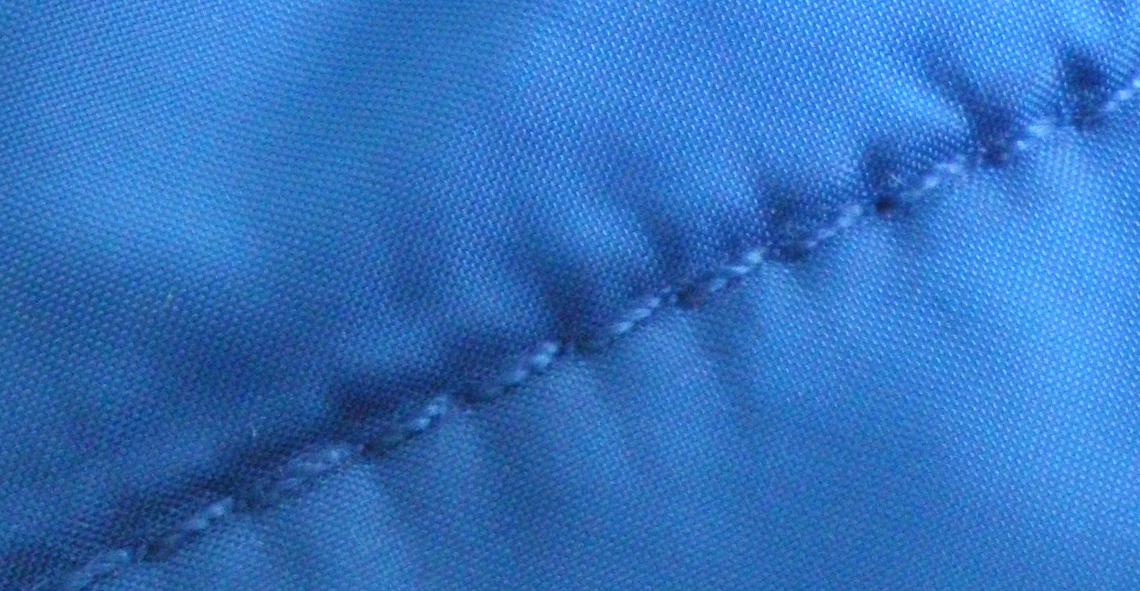What is Oil Bleeding?
“Oil bleeding” or “oil leaking” means “bleeding” of lubricants or yarn finishing agents from sewing or embroidery threads into the sewn or embroidered fabrics. As a result of this migration, oily marks or even stripes which look like long grease spots, appear along the seams. Usually the bleeding starts at the seam, particularly from a puncture site, running in warp and/or weft direction. In the majority of cases oil bleeding occurs during the first week after ready making, longer storage does not increase the oil bleeding appearance.
Why Does Oil Bleeding Occur More Often Nowadays?
The oil bleeding phenomenon mainly occurs on ready-made outdoor clothing and sportswear. More and more now, outer fabrics are made of superfine polyester or polyamide microfibers. Also, the finishing of the fabric has a significant influence on the oil bleeding. Oleophobic finishing is commonly only required for Personal Protective Equipment (PPE) or technical applications. Besides ecological reasons this is why nowadays textile fabrics are mostly waterproofed with fluorocarbon-free finishing agents which offer no oil repellency. But on textiles without oleophobic properties oily lubricants tend to spread into the fabric. Furthermore, in order to obtain an improved sewability, embroidery and sewing threads get often lubricated with very high amounts of lubricants. The higher the applied quantities, the higher the risk that the yarn lubricant is migrating from the embroidery or sewing yarn into the fabric.
Main Influence Factors on Oil Bleeding
After intensive, comprehensive research we identified three factors which have a major influence on oil bleeding:
- fabric construction
- textile finishing
- lubrication of sewing/embroidery threads
Fabric Construction:
Oil bleeding depends on the fabric construction as well as on the used fiber materials. The finer the fiber diameter of the warp and weft yarns and the tighter woven the fabric, the stronger the capillary forces and the higher the migration tendency of the lubricant from the sewing thread into the fabric.
Textile Finishing:
The finishing of the textile fabric is a crucial factor for oil bleeding. On textiles with water as well as oil repellent finishing, oily lubricants hardly tend to migrate from the yarn into the textile. However, there is a significant risk for oil bleeding on fabrics which were only hydrophobized with a fluorocarbon-free finishing.
Lubricants:
The chemistry of the applied lubricants as well as the application quantities have a significant impact on the oil bleeding performance of a sewing or embroidery thread. The higher the migration tendency of the lubricant’s ingredients and the higher the applied quantity on the yarn, the more significant is the oil bleeding risk.
Our Product Recommendation: PERIFIL ZOB
In order to minimize the risk of oil bleeding on delicate, sensitive fabrics, we have developed a new high-performance lubricant for sewing and embroidery threads made of polyester and polyamide: PERIFIL ZOB (Zero Oil Bleeding). With our new development we aimed for a lubricant, which has no migration tendencies and which provides the finished threads with the best processing properties even at low application quantities. This includes excellent friction properties and the ability to avoid stick-slip effects, low abrasion as well as good heat protection. PERIFIL ZOB effectively dissipates the heat stress from the hot sewing needle and thus ensures a proper sewability of the threads. PERIFIL ZOB is intended for being applied via precision pump systems, in order to ensure precise and low application quantities.
Do You Have Questions on Yarn Lubrication?

Do you have further questions on the finishing of sewing and embroidery threads? Please contact our experts. We will be glad to assist you.
- Rudi Breier
- Head of Development
- +49 7121 9589-21
- rudi.breier@drpetry.de


